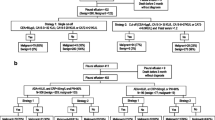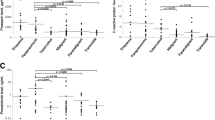Abstract
Our objectives were to study the value of different proteins in the serum and ascitic fluid and assess their potential in discriminating between malignant and nonmalignant ascites in a model that could be developed to aid clinical diagnosis. In all, 57 different measurements (30 in serum and 27 in ascitic fluid) including erythrocyte sedimentation rate, number of white blood cells, cytokines, interleukin-1a (IL-1a), IL-1b, IL-2, IL-6, IL-8, tumor necrosis factor-α, immunoglobulins (IgG, IgA, IgM), complement factors C3 and C4, acute-phase proteins such as α1-acid glycoprotein, α2-macroglobulin, α1-antitrypsin, haptoglobin, C-reactive protein, ferritin, ceruloplasmin and transferin, were performed in 61 patients with ascites (25 with malignant exudates, 13 with nonmalignant exudates, and 23 with transudates). Patients with sepsis were excluded. Correlation tests and one-way ANOVAs were used for comparisons between different groups. Discriminant analyses were used to assess the significance of each parameter in the differentiation process. Correct classification of 100% of cases required the use of all 57 ascitic fluid measurements in the model, which was not considered practical in clinical diagnosis. Discriminant analysis showed that five ascitic fluid measurements—total protein, LDH, TNF-α, C4, and haptoglobin—were sufficient for a model to correctly classify 89% of cases. Cross-validation showed that 70% of unknown cases were correctly classified using this model. In conclusion, we have shown that five easily taken protein measurements in the ascitic fluid can differentiate to a large extent between cases with ascites and have proposed a relatively simple statistical model with these parameters that could be developed to be extremely useful in the clinical setting.
Similar content being viewed by others
REFERENCES
Cascinu S, DelFerro E, Barbanti I, Ligi M, D Fedeli A, Catalano G: Tumor markers in the diagnosis of malignant serous effusions. Am J Clin Oncol 20:247-250, 1997
Kountouras J, Boura P, Tsapas G, Charisis K, Magoula I, Tsakiri I: Value of ascitic fluid ferritin in the differential diagnosis of malignant ascites. Anticancer Res 13:2441-2446, 1993
Dekker A, Bupp PA: Cytology of serous effusions: An investigation into the usefulness of cell blocks versus smears. Am J Clin Pathol 70:855-860, 1978
Arbillos A, Cuerras-Mous V, Millan I, Conton T, Montes J, Barrios C, Canido A: Ascitic fluid polymorphonuclear cell count and serum to ascites albumin gradient in the diagnosis of bacterial peritonitis. Gastroenterology 98:134-140, 1990
Runyon BA, Antillon MR: Ascitic fluid pH and lactate: Insensitive and nonspecific test in detecting ascitic fluid infection. Hepatology 13:929-935, 1991
Nystrom JS, Dyce B, Wada J, Bateman JR, Haverback B: Carcinoembryonic antigen titers on effusion fluid. Arch Intern Med 137:875-879, 1977
Prieto M, Gomez-Lechon MJ, Hoyos M, Castell JV, Carraso D, Berenguer J: Diagnosis of malignant ascites comparison of ascitic fibronectin, cholesterol and serum ascites albumin difference. Dig Dis Sci 33:833-838, 1988
Jungst D, Gerbes AL, Martin R, Paumgartner G: Value of ascitic lipids in the differentiation between cirrhotic and malignant ascites. Hepatology 6:239-243, 1986
Armitage P, Berry G: Statistical Methods in Medical Research, 2nd ed. Oxford, Blackwell Scientific Publications, 1987
Everitt BS, Dunn G: Applied Multivariate Data Analysis. London, Edward Arnold, 1991
Norusis MJ: SPSS Professional Statistics 6.1, Illinois USA: SPSS Inc, 1994
Rice JA: Mathematical Statistics and Data Analysis. California, Wadsworth, Inc., 1988, p. 384
Pare P, Talbot J, Hoefs JC: Serum-ascites albumin concentration gradient: A physiologic approach to the differential diagnosis of ascites. Gastroenterology 85:240-244, 1983
Rector WG Jr, Reynolds TB: Superiority of the serum-ascites albumin difference over the ascites total protein concentration in separation of transudative and exudative ascites. Am J Med 77:83-85, 1984
Yinnon A, Konijn AM, Link G, Moreb J, Hershko C: Diagnostic value of ferritin in malignant pleural and peritoneal effusions. Cancer 62:2564-2568, 1988
Gerbes AL, Jungst D, Xie Y, Permanetter W, Paumgartner G: Ascitic fluid analysis for the differentiation of malignancyrelated and nonmalignant ascites. Cancer 68:1808-1814, 1991
Scholmerich J, Volk BA, Kottgen E, Ehlers S, Gerok W: Fibronectin concentration in ascites differentiates between malignant and nonmalignant ascites. Gastroenterology 87:1160-1164, 1984
Lee CM, Changchien CS, Shyu WC, Liaw YF: Serum-ascites albumin concentration gradient and ascites fibronectin in the diagnosis of malignant ascites. Cancer 70:2057-2060, 1992
Colli A, Buccino G, Cocciolo M, Parravicini R, Mariani F, Scaltrini G: Diagnostic accuracy of fibronectin in the differential diagnosis of ascites. Cancer 58:2489-2493, 1986
Toussi A, Paquet N, Huber O, Fratiger S, Tissot JD, Hughes GJ, Hochstrasser DF: Polypeptide marker and disease patterns found while mapping proteins in ascitis. J Chromatogr 582:87-92, 1992
Villamil FG, Sorroche PB, Aziz HF, Lopez PM, Oyhamburus JM: Ascitic fluid α1-antitrypsin. Dig Dis Sci 35:1105-1109, 1990
Alexandrakis M, Coulocheri S, Kyriakou D, Bouros D, Xirouhaki N, Siafakas N, Castanas E, Eliopoulos GD: Diagnostic value of ferritin, haptoglobin, α1-antitripsin lactate dehydrogenase and complement factors C3 and C4 in pleural effusion differentiation. Respir Med 91:517-523, 1997
Wang SS, Lee FY, Chao Y, Chen CC, Lin HY, Wu SL, Lee SD: Clinical significance of complements in ascitic diseases: Elevated complement levels disapproving the liver disease origin. Proc Natl Sci Counc Repub China B 20:51-57, 1996
Schneider D, Halperin R, Langer R, Bilpvslu I, Herman A: Peritoneal fluid lactate dehydrogenase in ovarian cancer. Gynecol Oncol 66:394-399, 1997
Pruimboom WM, vanDijk AP, Tak CJ, Bonta IL, Wilson JH, Zijlstra FJ: Production of inflammatory mediators by human macrophages obtained from ascites. Prostaglandins Leukot Essent Fatty Acids 50:183-192, 1994
Cappuccini F, Yamamoto RS, Disaia PJ, Grosen EA, Gatanaga M, Lucci JA, Ininus EK, Gatanagos T, Granger GA: Identification of tumor necrosis factor and lymphotoxin blocking factor(s) in the ascites of patients with advanced and recurrent ovarian cancer. Lymphokine Cytokine Res 10:225-229, 1991
Propst T, Propst A, Herold M, Schauer G, Judmaier G, Braun-steiner H, Stoffler G, Vogel W: Spontaneous bacterial peritonitis is associated with levels of interleukin-6 and its secondary mediators in ascitic fluid. Eur J Clin Invest 23:832-836, 1993
Zeni F, Tardy B, Vindimian M, Contet C, Page Y, Cusey I, Bertrand JC: High levels of tumor necrosis factor-α and interleukin-6 in the ascitic fluid of cirrhotic patient with spontaneous bacterial peritonitis. Clin Infect Dis 17:218-223, 1993
Moradi MM, Carson LF, Weinberg B, Haney AF, Twiggs LB, Ramakrishnan S: Serum and ascitic fluid levels of interleukin-1, interleukin-6 and tumor necrosis factor-alpha in patients with ovarian epithelial cancer. Cancer 72:2433-2440, 1993
Overton C, Fernandez Shaw S, Hicks B, Barlow D, Starkey P: Peritoneal fluid cytokines and the relationship with endometriosis and pain. Hum Reprod 11:380-386, 1996
Zeimet AG, Widschwendter M, Knabbe C, Fuchs D, Herold M, Moller E, Daxenbichler G, Offner FA, Dapunt O, Marth C: Ascitic interleukin-12 is an independent prognostic factor in ovarian cancer. J Clin Oncol 16:1861-1868, 1998
Mayall F, Heryet A, Manga D, Kriegeskotten A: p53 immunostaining is a highly specific and moderately sensitive marker of malignancy in serous fluid cytology. Cytopathology 8:9-12, 1997
Author information
Authors and Affiliations
Rights and permissions
About this article
Cite this article
Alexandrakis, M.G., Moschandrea, J.A., Koulocheri, S.A. et al. Discrimination Between Malignant and Nonmalignant Ascites Using Serum and Ascitic Fluid Proteins in a Multivariate Analysis Model. Dig Dis Sci 45, 500–508 (2000). https://doi.org/10.1023/A:1005437005811
Issue Date:
DOI: https://doi.org/10.1023/A:1005437005811




